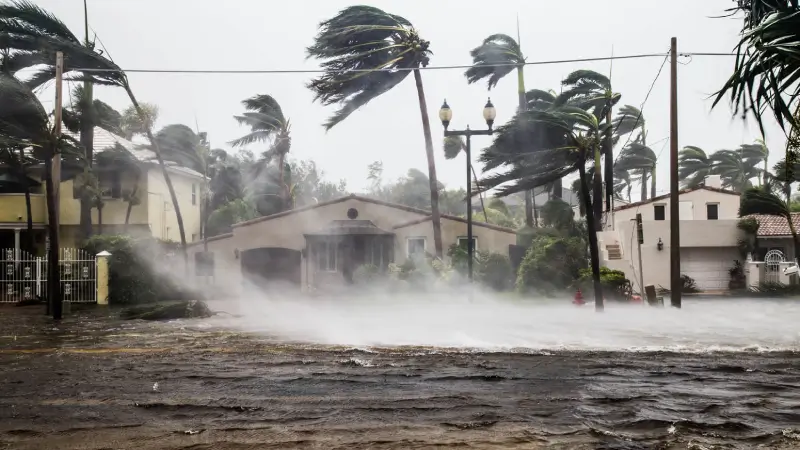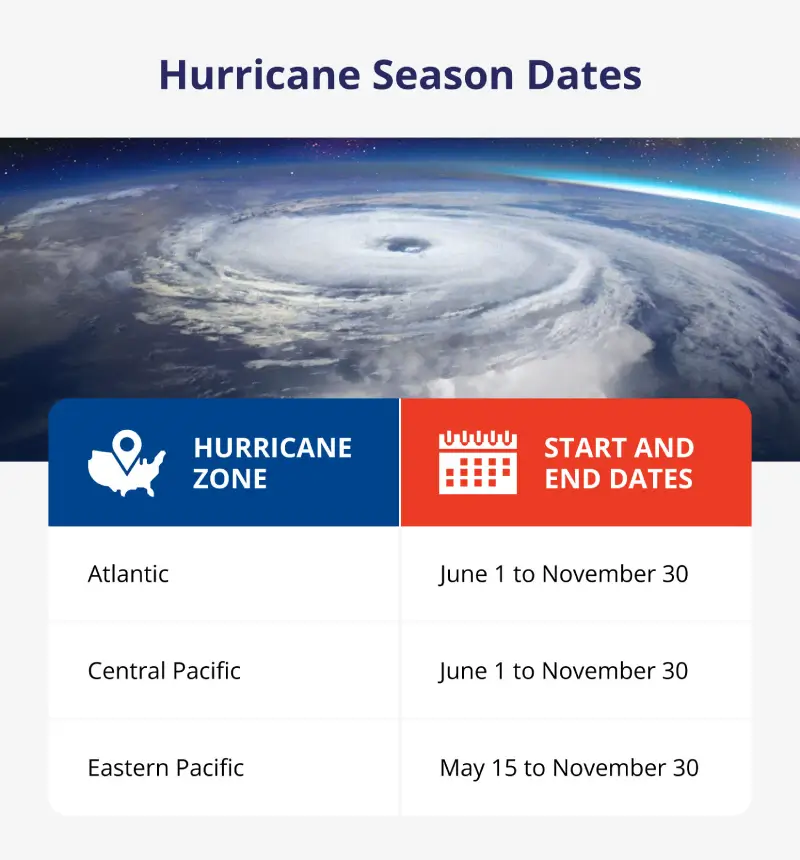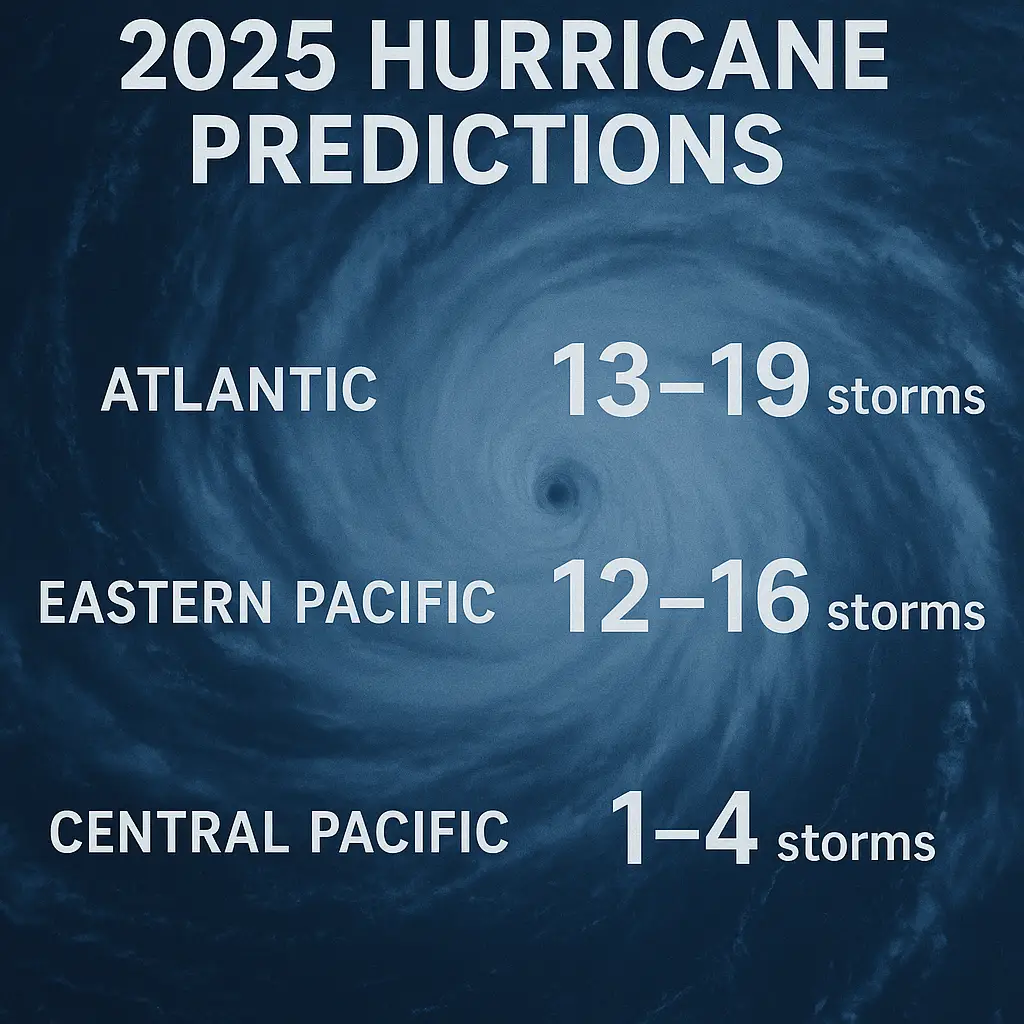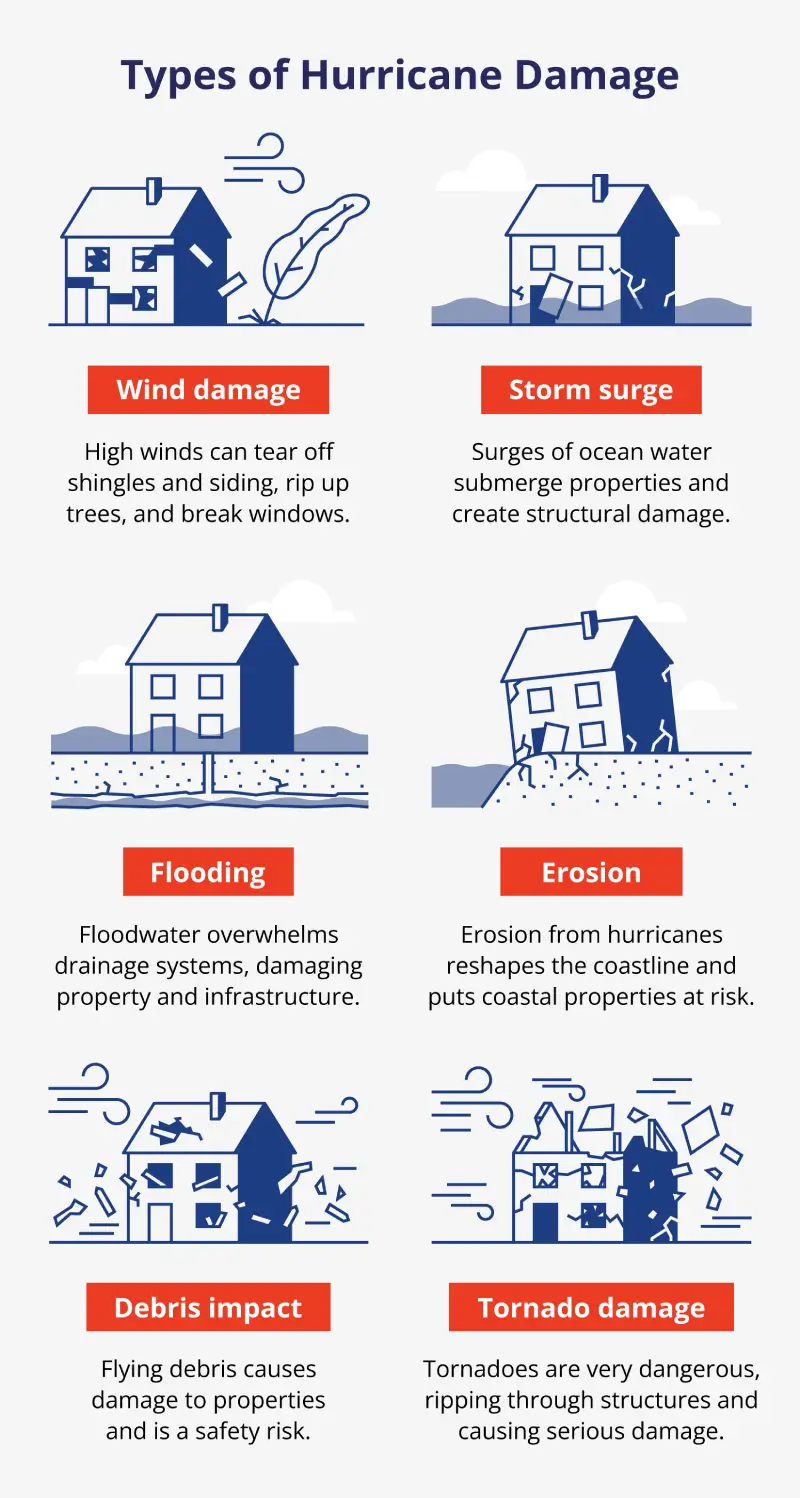
Rainbow Restoration explains forecasts for the 2025 hurricane season, including peak times and potential damages.
|
|
Summary: The 2025 Atlantic and Central Pacific hurricane seasons start on June 1. The 2025 Eastern Pacific hurricane season begins slightly earlier, on May 15. The NOAA predicts that the 2025 Atlantic tropical storm season will be more active than normal, while the 2025 Central and Eastern Pacific hurricane seasons are expected to be near-to-below typical activity levels. |
Taking proactive steps well before peak hurricane season can promote safety and reduce the costs of property damage. Information is the key to minimizing potential storm damage and navigating hurricane season with greater peace of mind.
Table of contents:
- When Is Hurricane Season?
- What Are the Hurricane Predictions for 2025?
- 2025 Hurricane Names
- Where Do Hurricanes Happen the Most?
- What Damage Can a Hurricane Cause?
- Trust Rainbow Restoration for Storm Damage Restoration
- 2025 Hurricane Season FAQ
When Is Hurricane Season?
The Atlantic and Pacific regions experience slightly different hurricane seasons, but generally, hurricane season falls between June and November. Awareness of hurricane season in your region can help ensure your property is always prepared for severe weather.
When is the 2025 Atlantic hurricane season?
The 2025 Atlantic hurricane season is projected to run from June 1 to November 30, with peak season from mid-August to late October. However, other tropical storms or cyclones can form outside these dates.
When is the 2025 Pacific hurricane season?
The Pacific hurricane season is divided by region: Central Pacific, the area east of 140°W longitude (off the western edge of the U.S. and Canada) to the International Date Line, and Eastern Pacific, the area west of 140°W to the coasts of Mexico and Central America.
- The 2025 Central Pacific hurricane season is projected to match the Atlantic, from June 1 to November 30, with peak activity between August and October.
- The 2025 Eastern Pacific hurricane season is expected to last slightly longer, from May 15 to November 30. Peak season occurs from July to September.
When is hurricane season over?
Both the Atlantic and Pacific hurricane seasons end by late November. However, tropical storms, typhoons, cyclones, and other large storms may still occur into December.

When is hurricane season in other parts of the world?
Other parts of the world experience different peak storm seasons. Typhoon season in the Western Pacific (encompassing the waters from the International Date Line to the coast of Asia) generally runs from June to December, with a peak from July to September.
In the South Pacific, cyclone season lasts from November to April (with a peak from February to March), impacting areas including French Polynesia, the Cook Islands, Australia, and New Zealand.
What Are the Hurricane Predictions for 2025?
The National Oceanic and Atmospheric Administration (NOAA) predicts above-normal hurricane activity for the Atlantic Basin in 2025, while the Central and Eastern Pacific are expected to experience normal to below-normal seasons.

Atlantic hurricane predictions for 2025
NOAA predicts a busy Atlantic tropical storm season in 2025, with an expected 13–19 named storms. This translates to a 60% higher chance of an above-average season compared to the historical average of 14 named storms.
A key factor in NOAA’s predictions are ENSO-neutral conditions, a state where neither El Niño nor La Niña significantly influences the ocean and atmosphere. Additional factors include warmer-than-average ocean temperatures, forecasts for weak wind shear, and the potential for higher activity from the West African Monsoon (a primary starting point for Atlantic hurricanes). These elements tend to favor hurricane formation in the Atlantic Basin.
Eastern Pacific hurricane predictions for 2025
NOAA’s 2025 Eastern Pacific tropical storm prediction indicates a 50% chance of a below-normal season. This prediction includes 12–16 named storms, of which 5–10 are expected to become hurricanes, with 2–5 reaching major hurricane strength.
The Eastern Pacific hurricane season outlook is based on a neutral ENSO phase. However, there is a possibility that La Niña may develop, which could influence the season by increasing vertical wind shear and reducing sea surface temperatures. This would favor milder storm activity.
Central Pacific hurricane predictions for 2025
NOAA predicts the 2025 Central Pacific hurricane season to be near-normal to below-normal. Forecasters expect 1–4 storms to enter the basin, which normally sees 3–4 tropical cyclones per season.
The Central Pacific region is predicted to have lower-than-average numbers of hurricanes due to a lack of strong El Niño or La Niña influence as well as sea surface temperatures and overall climate patterns.
2025 Hurricane Names
Atlantic and Pacific hurricanes use different lists of names, both rotating every six years. That means the names below last appeared in 2019 and will likely reappear in 2031!
2025 Atlantic hurricane names
Below are the Atlantic hurricane names for 2025.
|
Andrea |
Dexter |
Gabrielle |
Jerry |
Melissa |
Pablo |
Tanya |
|
Barry |
Erin |
Humberto |
Karen |
Nestor |
Rebekah |
Van |
|
Chantal |
Fernand |
Imelda |
Lorenzo |
Olga |
Sebastien |
Wendy |
2025 Eastern Pacific hurricane names
The Eastern Pacific hurricane season has a different list of names than the Central Pacific. Below are the Eastern Pacific hurricane names for 2025.
|
Alvin |
Dalila |
Gil |
Juliette |
Mario |
Priscilla |
Tico |
Xina |
|
Barbara |
Erick |
Henriette |
Kiko |
Narda |
Raymond |
Velma |
York |
|
Cosme |
Flossie |
Ivo |
Lorena |
Octave |
Sonia |
Wallis |
Zelda |
2025 Central Pacific hurricane names
Below are the Central Pacific hurricane names for 2025.
|
Akoni |
Iona |
Moke |
Pena |
|
Ema |
Keli |
Nolo |
Ulana |
|
Hone |
Lala |
Olana |
Wale |
Where Do Hurricanes Happen the Most?
The states most susceptible to hurricanes are concentrated along the Atlantic and Gulf Coasts. Hurricanes are most likely to make landfall and cause damage in the following states:
- Florida: Due to its unique location between both the Atlantic and the Gulf, Florida takes the top spot with the most recorded hurricane landfalls.
- Texas and Louisiana: Hurricanes that form in the warm waters of the Gulf of Mexico frequently make landfall on the Gulf Coast states.
- North Carolina: Although it doesn’t border the Gulf, North Carolina experiences hurricane activity due to its location along the Atlantic hurricane track.
South Carolina, Alabama, Georgia, and Mississippi also see their fair share of hurricanes, although typically with much less frequency and impact than the top four states.
The Western Pacific Ocean area, encompassing waters near Asia, is the most active tropical storm region worldwide, averaging around 16.5 typhoons per year. On the opposite end, the North Indian Ocean experiences the least activity, with an average of only 1.5 cyclones per year.
What Damage Can a Hurricane Cause?
Hurricanes can cause a wide range of damage depending on the storm's intensity and specific location. Destruction caused by hurricanes may include:
- Wind damage: A signature characteristic of hurricanes, high winds can tear off shingles, rip siding from walls, and snap trees. Wind can also break windows, allowing rain and debris to enter buildings and cause further damage.
- Storm surge: The massive surge of ocean water caused by a hurricane can inundate coastal areas, submerging homes and businesses. The force of the water can also cause structural damage to buildings.
- Flooding: Heavy rains associated with hurricanes can overwhelm drainage systems, leading to flash floods or prolonged flooding. Floodwater can contaminate belongings, damage electrical systems, and cause mold growth if not addressed quickly.
- Tornado damage: Hurricanes can spawn tornadoes, which are highly localized but extremely destructive. Tornadoes can rip through structures, causing severe roof and wall damage and posing a serious threat to safety.
- Debris impact: Flying debris from wind-whipped objects, such as roofing materials, furniture, or even entire trees, can cause significant damage to vehicles and structures. Broken windows from debris can lead to water damage.
- Erosion: Hurricanes don't just damage structures; they can significantly reshape the coastline. Powerful waves erode beaches and dunes, stripping away protective barriers and leaving coastal properties even more vulnerable to future storms and flooding.

Properties in impacted areas often require urgent water damage remediation and removal services after a hurricane. Rainbow Restoration® offers 24/7 emergency water damage restoration for homes and businesses in many areas throughout the United States and Canada.
Trust Rainbow Restoration for Storm Damage Restoration
With hurricane season running from May or June through November, thousands of properties are at an elevated risk of damage for nearly six months out of the year. With the Atlantic Basin expected to experience a higher-than-average hurricane season in 2025, property owners must be ready to weather the storms.
Rainbow Restoration offers a range of services to help homes and businesses recover from hurricane damage, including 24/7 emergency disaster restoration, water damage restoration and cleanup, and mold remediation and removal. With highly trained teams throughout the country, Rainbow Restoration is ready to restore storm-impacted properties to their best possible condition.
We provide residential and commercial storm damage restoration, including proactive emergency response planning. To learn more and schedule service, contact Rainbow Restoration today.
This article is intended for general informational purposes only and may not be applicable to every situation. You are responsible for determining the proper course of action for your home and property. Rainbow Restoration is not responsible for any damages that occur as a result of this blog content or your actions. For the most accurate guidance, contact the Rainbow Restoration location nearest you for a comprehensive, on-site assessment.
2025 Hurricane Season FAQ
Setting the highest standards in water, fire, and mold damage restoration requires a continuous dedication to education and improvement. This commitment to exceptional service also includes using our years of experience and expertise to answer your restoration questions. Here are answers to some of the most frequently asked questions about the 2025 hurricane season.
What is a hurricane?
A hurricane is a powerful tropical storm that forms over warm ocean waters and rotates around a central low-pressure system, forming a distinct spiral shape. Hurricanes are classified by their wind speeds, with stronger hurricanes posing greater danger to people and structures. In addition to heavy winds, hurricanes can cause severe flooding and storm surges. Hurricanes are also called typhoons or cyclones depending on the part of the world in which they form.
What month is the worst for hurricanes?
September is statistically the most active month for hurricanes, with September 10 marking the typical peak of the Atlantic hurricane season. Warmer ocean temperatures and low wind shear during the month contribute to more frequent hurricane development and landfalls.
Will 2025 be a bad year for hurricanes?
The NOAA predicts the 2025 Atlantic hurricane season to have higher-than-average activity. However, forecasters predict lower-than-average hurricane activity throughout the Pacific in 2025.
Which parts of the United States are most in danger of a hurricane?
Historically, Florida, Texas, Louisiana, and North Carolina have been the most impacted by hurricanes in the United States. Other states that experience less frequent hurricane activity include South Carolina, Alabama, Georgia, and Mississippi.
What part of Florida gets hit the most by hurricanes?
The northwest Florida Panhandle experiences the most hurricanes in Florida, largely due to its warm, shallow waters and low wind shear.
How are hurricane names chosen?
Hurricane names are assigned by the World Meteorological Organization (WMO) based on predetermined lists for each hurricane region. These lists include rotating, easy-to-remember names that alternate between male and female. This system helps avoid confusion while helping forecasters and the public track storms.
Hurricane name lists are used on a six-year rotation, meaning the 2025 names will likely reappear in 2031. Exceptions occur if a storm is particularly devastating, in which case the WMO retires the name to avoid future insensitivity.
